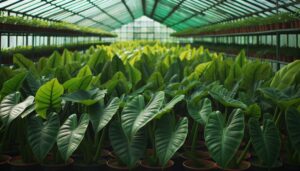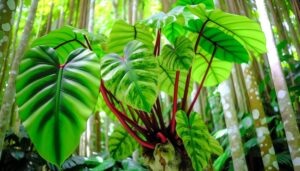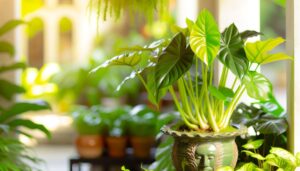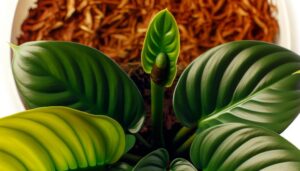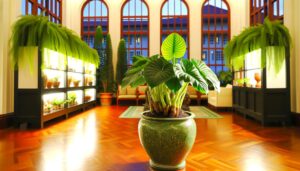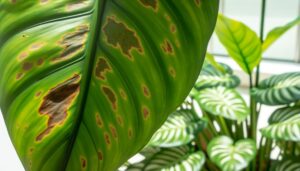What Is Philodendron Selloum Cum Laude?
Philodendron Selloum Cum Laude, botanically classified under the Araceae family, is a tropical South American plant prized for its deeply lobed, pinnatifid leaves. The plant can develop woody stems and produces aerial roots for support and nutrient absorption.
It thrives in bright, indirect light, with ideal temperature and humidity levels ranging from 18-24℃ and 60-80% respectively. The soil should be well-draining yet moisture-retentive, with regular fertilization during the growing season.
Proper pruning enhances air circulation and prevents disease. This plant's ability to adapt to interior environments makes it a popular choice for ornamental purposes.
Learn more about its distinctive features and care.
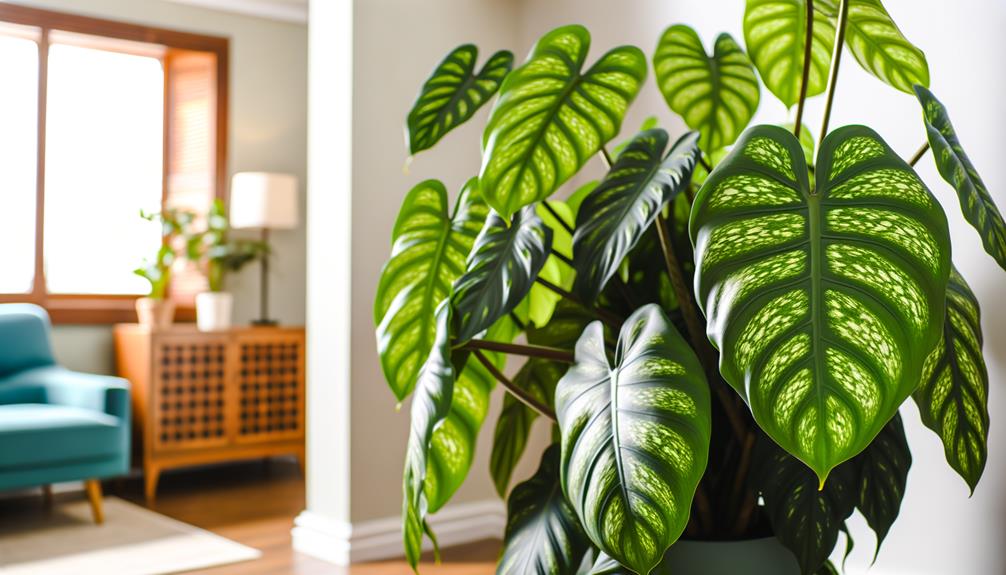
Key Takeaways
- Philodendron Selloum Cum Laude is a tropical plant from South America, classified under the Araceae family.
- It features deeply lobed, pinnatifid leaves that can grow up to 1.5 meters long.
- The plant thrives in bright, indirect light and requires well-draining, moisture-retentive soil.
- Ideal growing conditions include temperatures between 18-24°C (64-75°F) and 60-80% relative humidity.
- It is popular in Western horticulture for interior landscaping due to its adaptability and ornamental appeal.
Origin and History

Originating from the tropical regions of South America, the Philodendron Selloum, also known as Philodendron bipinnatifidum, has a rich history intertwined with indigenous cultures and modern horticulture.
Indigenous peoples utilized this plant for both ornamental and practical purposes, recognizing its unique adaptability to various environments.
Botanically classified under the Araceae family, Philodendron Selloum was formally described in the early 19th century by European botanists.
Its introduction into Western horticulture marked a significant milestone, as it became a popular choice for interior landscaping due to its lush foliage and ease of care.
The plant's robust nature has since facilitated its global dissemination, making it a staple in botanical gardens and private collections alike.
Unique Features
The Philodendron Selloum exhibits several distinctive morphological characteristics, including deeply lobed, pinnatifid leaves that can reach impressive dimensions of up to 1.5 meters in length. The foliage presents a glossy, dark green appearance, contributing to its ornamental appeal.
The stem is robust and can develop a thick, woody texture as it matures. Aerial roots emerge from the nodes, aiding in structural support and nutrient absorption. Additionally, this species displays a remarkable ability to adapt its growth habit, ranging from a ground-covering form to a more upright, tree-like structure.
The inflorescence comprises a spadix and spathe, typical of Araceae family members, though it is rarely observed in indoor cultivation. These unique features make Philodendron Selloum a highly valued specimen in botanical collections.
Ideal Growing Conditions
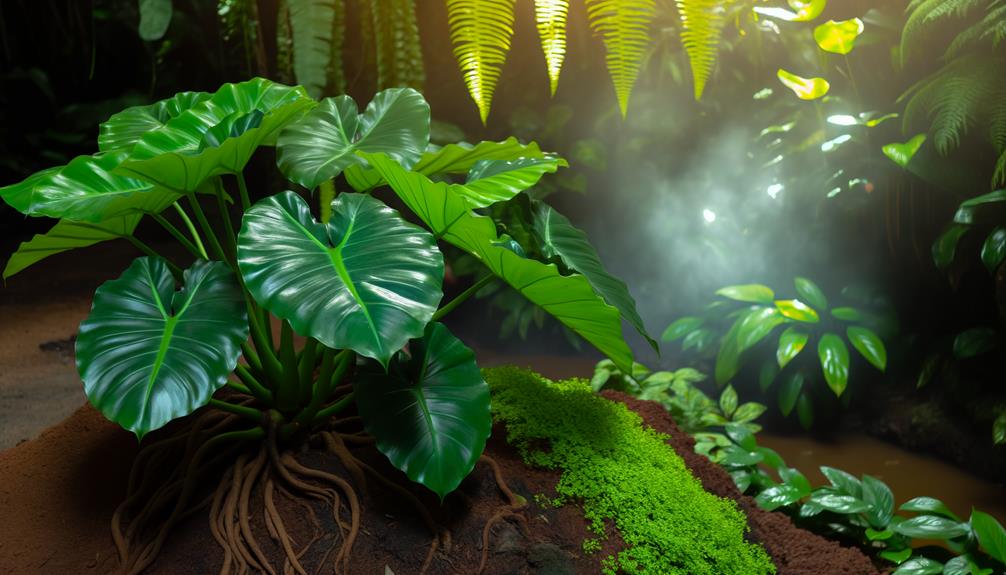
Ideal growth of Philodendron Selloum necessitates specific environmental parameters. These encompass temperature, humidity, light intensity, and soil composition. Best temperature ranges between 18-24°C (64-75°F), ensuring the plant's metabolic functions remain efficient.
Relative humidity should be maintained between 60-80%, mimicking its native tropical habitat to prevent desiccation and promote vigorous growth. Light intensity is essential; Philodendron Selloum thrives in bright, indirect light, avoiding direct sunlight that may scorch the foliage.
Soil composition should be well-draining yet moisture-retentive, ideally an aroid mix containing peat, perlite, and organic matter to maintain aeration and prevent root rot. Proper pH levels should be slightly acidic to neutral, ranging from 5.5 to 7.0, to facilitate nutrient uptake and overall health.
Watering and Feeding
Effective watering and feeding schedules are vital for maximizing the growth and health of Philodendron Selloum, requiring a balance that addresses the plant's specific moisture and nutrient requirements.
Watering should be consistent yet moderate, making sure the soil remains moist but not waterlogged to prevent root rot. Using well-draining soil and pots with drainage holes is essential.
Feeding should involve a well-rounded, water-soluble fertilizer administered bi-monthly during the growing season (spring and summer). High-nitrogen fertilizers can encourage lush foliage, while potassium and phosphorus support overall plant health.
Regular monitoring of soil pH, which should ideally range between 5.5 and 6.5, guarantees optimal nutrient uptake.
Proper hydration and nutrition are key for maintaining Philodendron Selloum's vibrant growth and resilience.
Pruning and Maintenance
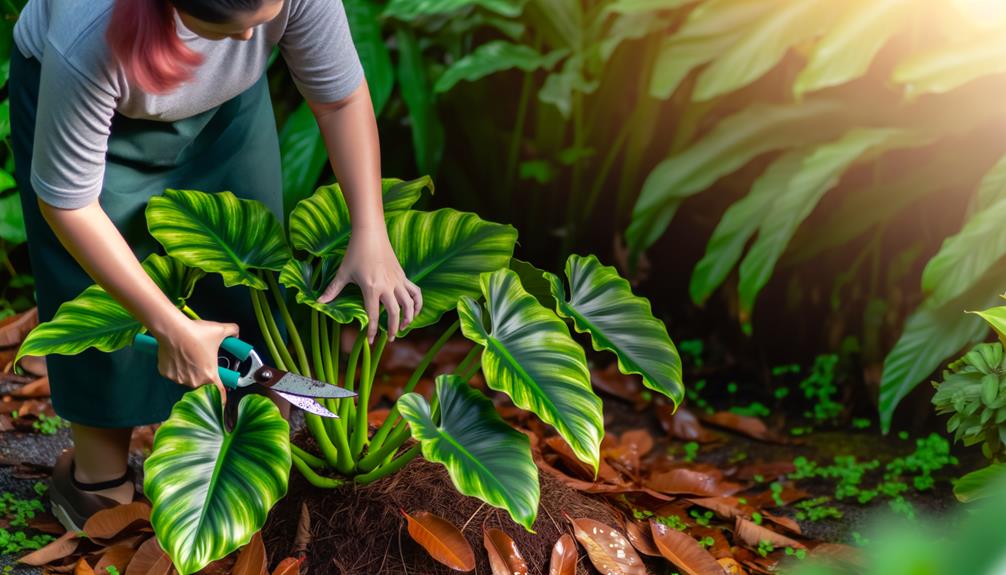
Pruning and maintenance are critical for the best growth and aesthetic appeal of Philodendron Selloum. Employing proper pruning techniques guarantees the removal of senescent foliage and promotes healthier growth patterns.
Maintenance best practices, including periodic inspection and cleaning, help mitigate pest infestations and disease proliferation.
Proper Pruning Techniques
A careful approach to pruning Philodendron Selloum is crucial for maintaining its structural integrity and promoting best growth. Employing the correct techniques will help the plant remains healthy and aesthetically pleasing. Utilize sharp, sterilized pruning shears to make clean cuts, removing dead or diseased leaves and stems. Focus on cutting just above a leaf node to encourage new growth. Prune during the growing season, preferably in spring or early summer.
| Pruning Task | Recommended Action |
|---|---|
| Dead Leaf Removal | Cut at the base, close to the main stem |
| Diseased Stem Removal | Remove entirely, making sure to cut below the affected area |
| Size Control | Trim back to desired size, ensuring even cut distribution |
| Shape Maintenance | Prune selectively to maintain the desired aesthetic form |
These practices will facilitate vital plant health and visual appeal.
Maintenance Best Practices
Maintaining the health and aesthetics of Philodendron Selloum requires a systematic approach, integrating both regular pruning and general care practices. Pruning should be executed with sterilized, sharp pruning shears to prevent pathogen transmission and ensure clean cuts. Target removal of senescent, yellowing, or damaged leaves to promote peak photosynthetic efficiency. Additionally, thinning congested areas facilitates air circulation, mitigating fungal diseases.
General maintenance encompasses soil moisture management, ensuring well-drained, aerated media to prevent root rot. Fertilization with a balanced, water-soluble fertilizer at half strength every 4-6 weeks during the growing season supports nutrient requirements. Regularly monitor for pests, employing appropriate integrated pest management (IPM) strategies.
Lastly, maintain ambient humidity levels between 60-80% to replicate the plant's native tropical habitat.
Common Pests and Issues
Philodendron Selloum is prone to a variety of pests and diseases that can significantly impact its growth and overall health. It is crucial to identify and manage these issues promptly to maintain plant wellness.
Common pests include:
- Spider Mites: These arachnids cause stippling and yellowing of leaves, leading to defoliation if unchecked.
- Mealybugs: These insects secrete a waxy substance, causing leaf yellowing and stunted growth.
- Scale Insects: These pests attach to stems and leaves, sucking sap and leading to weakened plant structure.
In addition to pests, Philodendron Selloum may encounter fungal and bacterial infections, often resulting from overwatering or poor air circulation. Regular inspections and appropriate cultural practices are essential to mitigate these threats effectively.
Decorating Tips
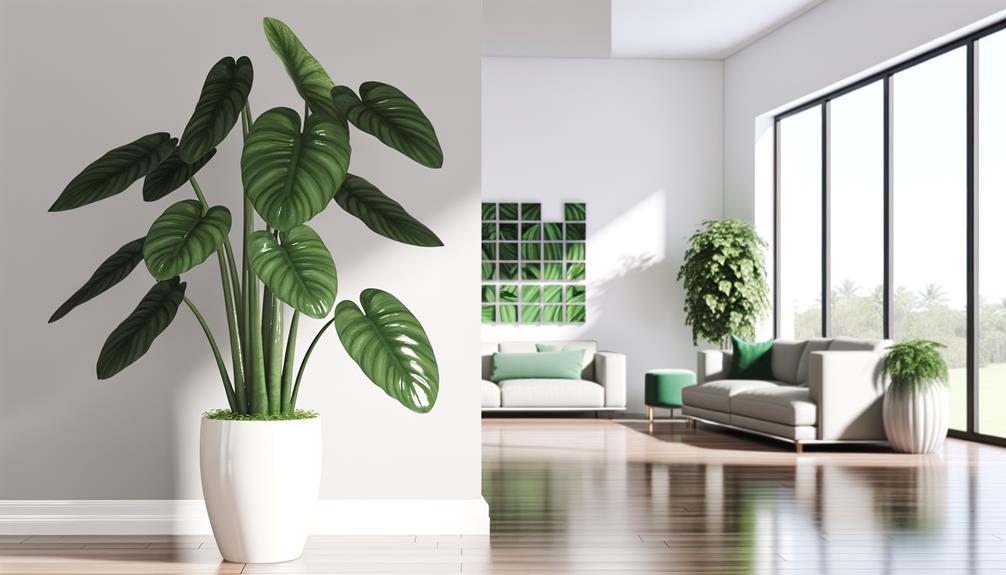
When integrating Philodendron Selloum into interior spaces, strategic placement and ideal lighting conditions are paramount to its health and aesthetic value.
This species thrives in indirect, bright light, which fosters robust growth and vibrant foliage.
To enhance visual appeal, consider complementary decor elements that accentuate its lush, tropical leaves, creating a cohesive and striking design.
Placement and Lighting
Best placement of Philodendron Selloum involves situating the plant in an area that receives bright, indirect light to support its photosynthetic needs while preventing leaf scorch. Optimum lighting conditions are essential for maintaining the plant's lush foliage and overall health.
Consider the following guidelines for placement:
- Proximity to Windows: Position the plant near east or north-facing windows to guarantee sufficient ambient light without direct sun exposure.
- Artificial Lighting: Utilize full-spectrum grow lights if natural light is inadequate, maintaining a distance of approximately 12-18 inches from the plant.
- Avoid Harsh Conditions: Refrain from placing the plant in areas with extreme temperature fluctuations or direct drafts, as these can stress the foliage and hinder growth.
Implementing these practices will lead to a thriving Philodendron Selloum.
Complementary Decor Ideas
Integrating Philodendron Selloum into interior decor requires strategic placement to enhance aesthetic appeal while maximizing growing conditions.
Position the plant in areas with indirect sunlight to enhance photosynthesis without causing photodamage. Utilize minimalistic or Scandinavian design elements to accentuate the plant's lush, lobed foliage.
Incorporating natural materials such as wood and stone can create a harmonious environment that complements the plant's organic aesthetic. Employing neutral color palettes will allow the vibrant green of the Philodendron Selloum to stand out as a focal point.
Additionally, consider using elevated plant stands or hanging planters to maximize visual impact and promote healthy growth, while preventing potential fungal infections by ensuring ideal air circulation around the foliage.
Conclusion
Philodendron Selloum 'Cum Laude' epitomizes the essence of tropical grace, serving as a lush beacon in botanical collections. Its abundant foliage and resilience symbolize nature's art of balance and adaptation.
Peak growth, akin to a symphony, requires specific conditions: humidity, light, and nutrition. Trimming and watchfulness against pests secure the plant's health, much like a guardian protecting a treasure.
This specimen not only elevates decor but also embodies the unity between human creativity and natural beauty.

